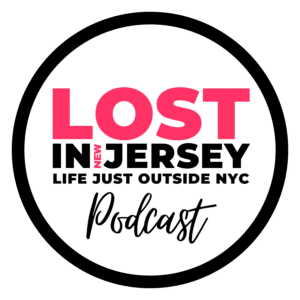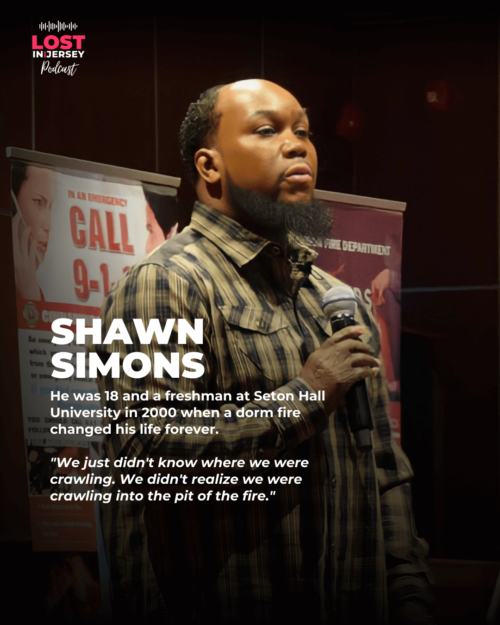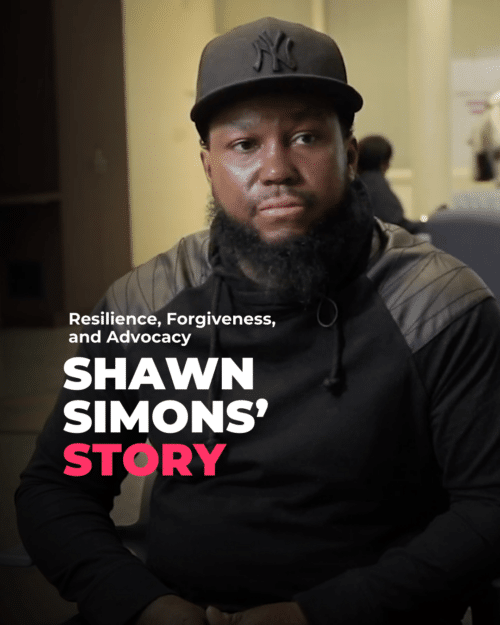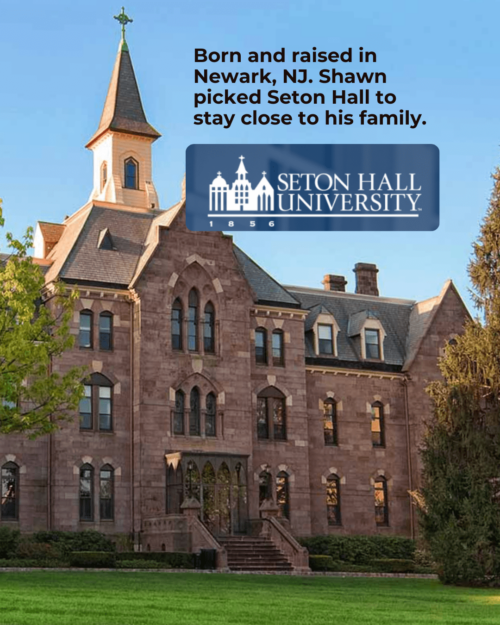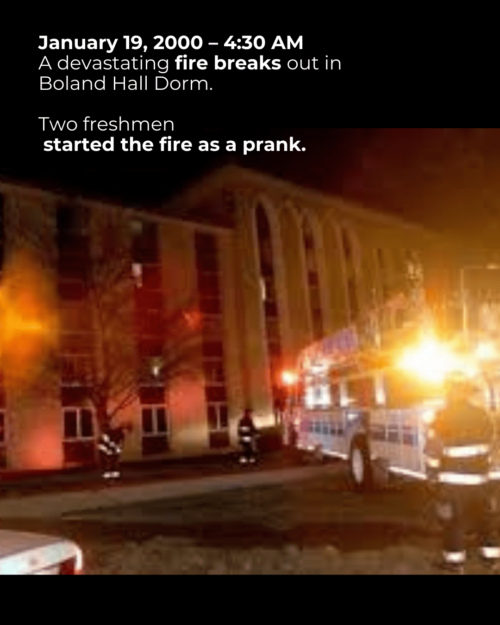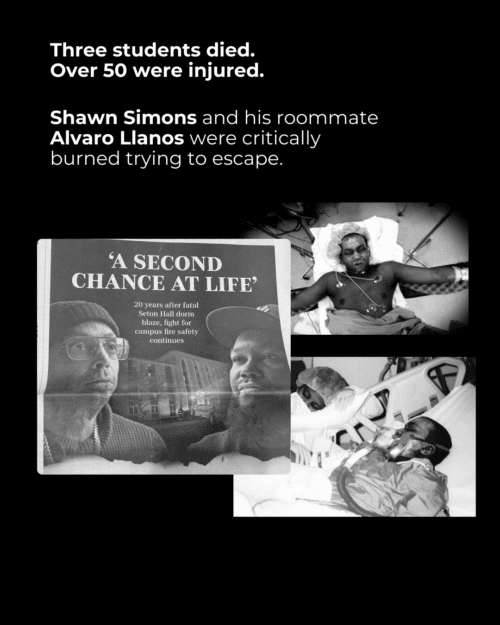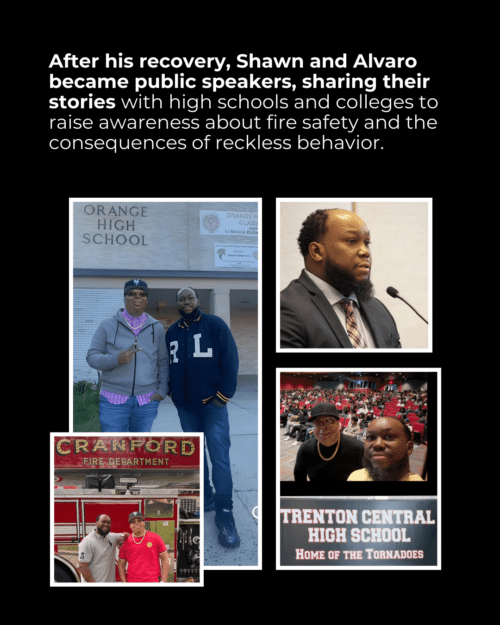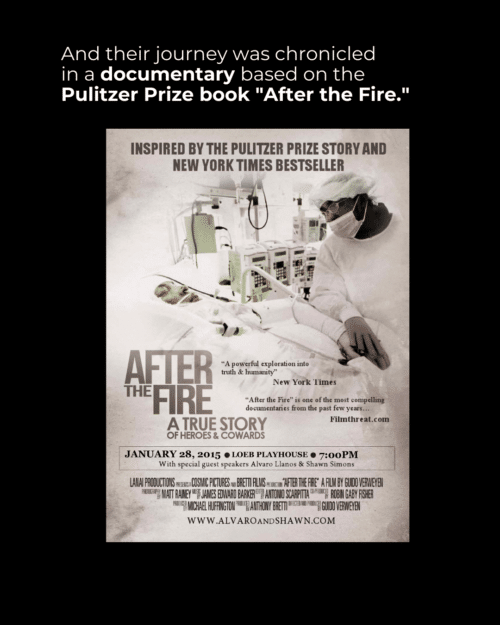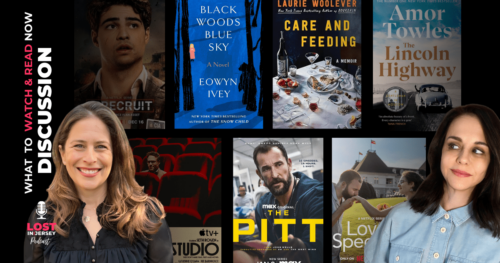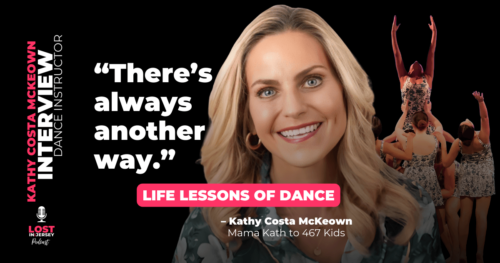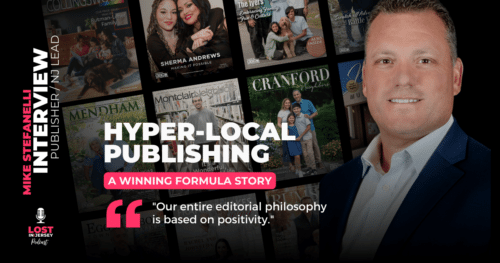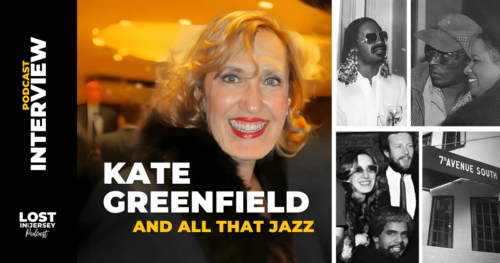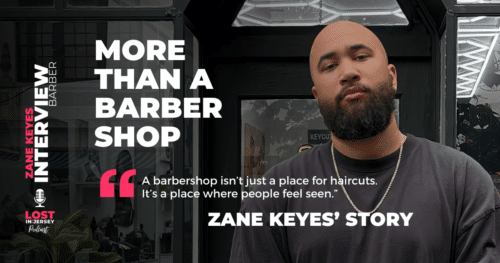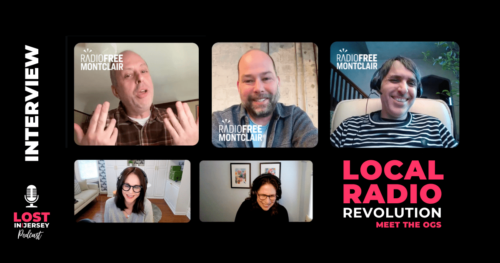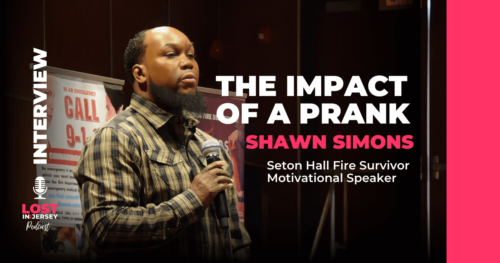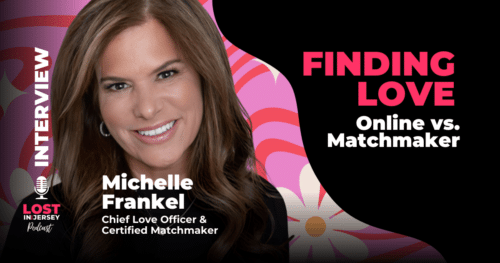Listen or Watch
Chapters
[00:00:44] Fire safety awareness and pranks.
[00:04:09] Consequences of false fire alarms.
[00:08:47] Emergency response during a crisis.
[00:12:46] Support system after trauma.
[00:16:08] Remorse and justice in tragedy.
[00:18:21] Fire safety advocacy and education.
[00:23:16] Forgiveness and personal healing.
[00:25:34] Life in a coma.
[00:28:22] Campus support after tragedy.
[00:31:54] Adversity and personal growth.
[00:36:22] Impact of fire safety regulations.
[00:39:22] Diversity of New Jersey.
Transcript
CO-HOST:
Hi, Janette. Hi, Rachel. We just got off a very inspiring conversation with Shawn Simons.
CO-HOST:
Yes, I’m still on a high from our conversation with Shawn.
CO-HOST:
Well, there’s many documentaries that have been done. A famous book that was written about his experience at Seton Hall. There was a fire in January 19th, 2000, almost 25 years ago.
CO-HOST:
In a freshman dorm.
CO-HOST:
And he and his roommate survived the fire.
CO-HOST:
But they were very badly burned and went through a year of rehabilitation and many other things. So it was a devastating, as he said at the time, it was the worst dormitory college fire in like a hundred years.
CO-HOST:
because of what they went through he has become a public speaker he goes to high schools and he and his roommate go together and talk about what they went through and fire safety awareness and also talking about things that no one ever thinks about you know when they’re heading into college about that safety and also for pranks and practical jokes because it was two fraternity, freshman fraternity kids that did the prank of setting a banner on fire, a bulletin board banner on fire that caused the fire and he’ll tell us about all, about the moments and the events in this interview and what he has gone on to do which as we learned towards the end of the interview every dormitory in New Jersey now has a sprinkler system in every room above their bed because of what they went through.
CO-HOST:
Yep. And unfortunately, not every state has that rule. That’s right. Not even close. We learn so much. And just what a compassionate, resilient, joyful person Shawn is. And he gives back to the community every single day. And it’s a beautiful story out of something horrible. Yeah, it is.
CO-HOST:
So without further ado, here’s the interview with Shawn Simons. Shawn, thank you so much for joining us on Lost in Jersey. It’s a pleasure to meet you.
SHAWN SIMONS:
Pleasure to meet you guys. I’m so glad to be here. Thank you.
CO-HOST:
Thank you. So I reached out to you because I was looking with the fires that happened in California recently. I was looking around about fire safety and like maybe trying to get someone from the New Jersey state to come and talk to us. And then I saw you. on LinkedIn in a picture with, I guess it was a New Jersey fire official. And then I started looking closer at your story and I was like, oh my gosh, will he come on the podcast? And you said, yes. So thank you so much for responding and coming on and to tell your story. First, we always ask people your connection to New Jersey before we get into the story. Right.
CO-HOST:
Did you grow up here?
SHAWN SIMONS:
Yeah, so born and raised in Newark. I went to high school in Newark. Decided to go to Seton Hall, which was literally eight blocks away from where I grew up from. I had been accepted to Georgetown, to Cornell, and of course to Seton Hall. And I decided, hey, I want to stay home. I want to stay in Jersey. I love it that much. Plus, I wanted to stay closer to my mom and go right up the street to Seton Hall.
CO-HOST:
And it’s a great school and so makes complete sense. So you stayed in state and you went off to college and this is where your life completely took a very significant turn. Yes. And this is the story that has been 25 years ago, actually almost, you know, a couple of weeks ago, correct? That everything changed.
SHAWN SIMONS:
Yes. So yes, January 19, 2000. My life as I knew it completely changed. It was a fraternity prank going wrong in our dormitory where two individuals at 4.30 in the morning decided to light a bulletin board on fire. And because we had had so many false alarms leading up to this fire, where students would constantly just pull the alarms just to ask pranks or to get people out the building. We became very complacent. And I kind of attribute our story to the story of the boy that cried wolf. You know, you can cry wolf so many times, but when a wolf comes, a lot of times you’re not prepared. And we weren’t prepared, you know, that night to be able to get out the building as far as our safety. So that’s how our lives changed forever because of that night.
CO-HOST:
I know you do take your story around to schools and to help especially teenagers who aren’t always thinking clearly when they do things and about consequences. You talk about this to schools to help educate kids going off to college or just becoming an adult and how to not set a fire, but also what to do if there is one. So when, will you take us back a little bit to what that, you woke up to this 430 alarm and what you personally were thinking?
SHAWN SIMONS:
So yeah, when I woke up to the sound of the alarms, I just assumed once again, it was another false alarm. Me and my roommate Alvaro, we kind of took our time. It was a very, very cold winter morning. It was like below freezing, I know for a fact. So we took our time. We got fully dressed because we didn’t know how long we would have to stand outside before they allowed us to go back in. And during that time, the fire was growing larger and larger. We had no idea that it was a real fire until we opened up the door and a cloud of smoke just kind of burst into the room. And And at that point in time, I kind of turned around and I said to Al, I said, this is the real deal. And just because of, I guess, prior learning as a kid, some fire safety stuff that I remembered, they say, hey, you know, when there’s a lot of smoke, get on your hands and knees and crawl. And that’s exactly what we did. But we just didn’t know where we were crawling. We didn’t realize we were crawling into the pit of the fire, which was on the third floor, where our floor was. I tell people all the time, fire is not like how it looks on TV with this orange glow and you can see everything and you see people running around. It was complete darkness. And we didn’t know if the fire was upstairs, downstairs in someone’s room. We just had no idea. And unbeknownst to us, we crawled directly into it.
CO-HOST:
I read that you found a stairwell, and then you then had to go to another stairwell. Is that correct? And your friend Al, he’s your roommate at this time, and he’s following along with you, I guess. And in the second stairwell, you saw that there was fire, but you realized at that point you have to just keep going. Is that correct?
SHAWN SIMONS:
Well, not 100% accurate. I crawled past the first stairwell, which was the way that we normally went if there was just a regular fire alarm. If the elevators weren’t working, we would take that stairwell. Like I said, because of the blindness of the smoke, I actually passed by that stairwell where Alvaro actually went that way.
CO-HOST:
So you didn’t see it?
SHAWN SIMONS:
I never saw it, no. I just kept crawling. What I ended up doing was I ended up crawling past the fire, in essence, into someone’s dorm room who had left their door open. And the only reason I was able to see that, you know, because I saw like the nightlight from outside because their door was open. So I crawled into that room. And once I crawled into that room, I just kind of looked at it and said, I have to get out of here because there was so much smoke coming into the room. So I literally crawled back on my hands and knees down to an exit, which was on the other end of the building and was able to get out that way.
CO-HOST:
And did you feel yourself burned or no? Was it?
SHAWN SIMONS:
No, you know, it was the adrenaline. There was so much adrenaline pumping. It was the shock of everything that was going on that. I had no idea that I was burned. I felt the heat when I crawled past the fire. Fortunately for me, none of my clothing actually caught on fire, so I didn’t have to deal with any of that. So when I got outside, I stood up, I walked outside to the to the cafeteria, which was across from where our dorm was. And I literally was going in there and someone said to me, I think you need medical attention. And I’m like, for what? You know, Not realizing I had been burned. I was in complete shock and I had been burned on 15% of my body.
CO-HOST:
My goodness. And then you got, when you finally got to the medical attention, did you like realize how bad it was yet?
SHAWN SIMONS:
No. You know, when I finally got into an ambulance, I laid down on a gurney and I’ll never forget the look on the EMT’s face. He just had a look of almost shock. And, and I would later find out that I was the first burn patient that he had ever picked up. So it was something new for him. Not that he was scared. He was trained for it, but it was just a moment of shock for him as well. And when I saw that look of shock on his face, I knew at that point in time, something was, was bad. Um, I just didn’t know the severity of it at that point. Wow.
CO-HOST:
So at that time, I mean, 50 people plus 50 people were injured. Three people died. What goes through your mind at that moment when you’re at the ambulance, you know something’s now happening for real?
SHAWN SIMONS:
Yeah, you know, it’s just, you’re just disoriented, you’re confused. Remember, this is 4.30 in the morning, so to be awakened by this and it be an actual fire is just kind of alarming. To see the people just scattering around everywhere and then starting to see the, you know, the first responders show up to campus. It was just like, I can’t believe what’s happening, but still also not realizing that I was as badly hurt as I was. You know, not only the burns, but I had suffered an enormous amount of smoke inhalation, which was actually probably the thing that was going to kill me more than the burns was. And not realizing that my lungs were starting to kind of shut down at that point, but it was just the adrenaline that just kept me going that I didn’t even, you know, process it.
CO-HOST:
And so then that you get to the hospital and they inform your family, I’m assuming right away. I mean, what, do you remember when you first saw your mom?
SHAWN SIMONS:
Yes, so I was sent up to St. Barnabas to the burn unit there in Livingston, and they said that I was conscious when I got to the emergency room, but I honestly, I don’t, I remember the ambulance ride to the, to St. Barnabas, which was a short distance away from Seton Hall. But I don’t recall anything else happening inside of the hospital. I didn’t see anyone for almost three weeks because I was placed into a medically induced coma. And at that point in time, that’s when I was finally able to, well, for me to be able to see, you know, my parents and see my mom for the first time. Even at that point, I couldn’t talk because I was kind of, I was still incubated. So I had a breathing tube down my throat and wasn’t able to communicate fully with them. But it was just a, I think, a relief to be able to see some loved ones, but not realizing still at that point in time that it had been three weeks. Like I thought it was the next day. And not realizing I had been in a coma for that long.
CO-HOST:
My goodness. Do you remember the initial feelings when you start to understand or start to process as you come out of the coma and your family is there and I’m sure that they’re distraught? I mean, I guess it all, what is the environment like and how are you responding to such a tragic event now that you’re on this other side of it, of coming out of the coma?
SHAWN SIMONS:
Yeah, you know, it was a, I don’t know, it was a sense of, I guess I was, I was definitely scared. I was, I, because I was in an unknown place. I actually woke up when they, I guess they started weaning me off the, out of the coma. I woke up inside what’s called the tank room, which is a sort of the room where they do the debriding of your skin and they wash you up on a, on a daily basis so that you don’t get the infection and it can change your wounds. Um, so I woke up on the table inside the tank room and immediately, as soon as I was able to, you know, gain a little strength, like I hugged the first person I saw. And it’s actually funny because there was the star legend newspaper covered our recovery after the fire. And the photographer was in the tank room with me the first time I woke up and he had this beautiful picture of me. reaching to hug one of the nurses who was cleaning me at the time. And I was just, I, I, I knew that there was such, I knew that there was some type of tragic thing that happened. I didn’t know at that point, the severity of, you know, the fact that we had lost classmates and stuff, but I knew I had been injured and I was just so thankful that somebody was there to, to, to just touch that at that point.
CO-HOST:
Yeah.
SHAWN SIMONS:
It was, it was, you know, like I said, it’s a great shot and especially in the context of what was happening.
CO-HOST:
seen, I’ve seen those photos and it is, they’re very moving. Many documentaries have been made about this event and Pulitzer Prize books have been written on what all you went through and what everybody had gone through. How did you find your way going, you know, coming back out of this dark place?
SHAWN SIMONS:
Yeah, you know, going through a traumatic experience is different for everyone. For me, I have to really attribute a lot of it to my support system between my family, my friends, the Seton Hall community itself, the nurses, the doctors. Everybody was championing us to recover. I always say that our story is unique because of where it happened, because it happened here in New Jersey, being so close to New York City, the media coverage that it received, the fact that this had been one of the deadliest college dormitory fires in over 100 years. Wow. It just got so much publicity and attention focused on it that it ended up helping us in a sense because we started to like get letters and cards from kids all over the country. People would be sending, you know, and this is this is, you know, kind of. like we were just at the stage of having cell phones and stuff like that. So, you know, still snail mail was a big thing. It wasn’t like a lot of emails and stuff like that. But it was incredible to wake up and look on my room wall and see the cards from people all over the country just saying, hey, we heard about your situation. We’re praying for you. We’re there for you. We support you. That was huge in the recovery process, just knowing that people cared. There were so many people who I think started to relate their situation in life to ours, like in a condition of living in a dorm before where fire alarms had went off and people took them as jokes or didn’t evacuate when they heard them. And they looked and said, wow, that could have been me. That happened not only at Seton Hall, but at any campus across the country. And I think a lot of people, the story really hit home for them that said, you know, what are we doing in this country to protect young adults who are living on college campuses? And, you know, I always, like I said, I think that sometimes we have to have tragedy happening in order to figure out a way to prevent it from happening in the future.
CO-HOST:
Right. Well, you know, I think people who are listening and the story’s new to them, they probably are curious about who set the fire and what happened with them. John Ryan and Joseph Lepore both were tried and convicted of having started the fire, but they didn’t spend a lot of time. And it was a little over 20 months that they served for this. And they did show remorse after a plea deal, which We were talking about this prior to the interview of how the system is. It’s a little tricky because we understand that their attorneys kind of told them to not speak about it. So they didn’t display a lot of remorse for many years. And they held out the case for a long time. So that part of the case is kind of a. It’s hard. It’s a hard part of like trying to get the message through to people. You know, you’ve got this fraternity kids doing a prank. It’s very cliche, you know, like fraternity brothers and then them not really owning up and showing the remorse that you need. That’s opposed to the so many people taking the time to write a letter to you and care about you, and then seeing that there are, again, sometimes maybe some people that can’t find that. Does that still sit with you in life, like that polar kind of situation?
SHAWN SIMONS:
Well, you know, I always say that I believe that these two guys didn’t do this intentionally to hurt anybody or kill anybody. I think they got drunk. They made a really, really bad decision, and this was the result of it. As you said, we never got the opportunity to really hear from them, mainly because of the advice of their counsel. And even to this day, we have never heard from them. They’ve never reached out to us to kind of apologize. And I always say, I don’t necessarily need an apology from them. I always say that my mother and my father had a chance to come to the hospital to see if I was going to make it. Three of our classmates, Frank, John, and Aaron, their parents didn’t get that opportunity. Their parents got that phone call that morning and said they had to come identify their children’s bodies. They were the ones I wish that they would have apologized to. And I think people would have been able to have a little bit more closure, even though I don’t think you ever get closure from losing a child. But I think the process of healing would have started a lot easier. As you mentioned, for this trial to be delayed almost seven years after the fire, it was just like pouring salt in the wound. They were out free, living their lives, doing whatever they wanted to do. And all of these families were suffering with either losing a loved one or we were suffering with the care that we had to, you know, the recovery process.
CO-HOST:
Yes.
SHAWN SIMONS:
And they really showed no remorse. And to me, that was almost a slap in the face, especially as you mentioned, the shortness of the period of time that they had to spend in jail. I know, like I said, they didn’t, their intentions weren’t to commit murder. But, you know, they also, I think they deserve more time than what they got. And it is, you know, it is our justice system that sometimes shows favor to some and not to others. But, you know, it is what it is. I mean, I can’t go back and change what they did. I can only live with the fact of, you know, who I am and how I become stronger because of what they did.
CO-HOST:
So moving past that, a part of it is that you have been the one that has gone out to teach people and to make changes and help the community increase the laws for fire safety within dormitories and sprinkler systems and things like that. Tell us about this road to advocacy.
SHAWN SIMONS:
Sure, so that there was a void in teaching young adults about the importance of fire safety and fire prevention. When I was a college freshman, and I remember starting at Seton Hall, maybe one of the RA’s said something in a floor meeting about, hey, you know, exit the building when the fire alarm goes off, and that probably was it, you know. But remember, and to me, I always say this, and it’s, you know, it’s unfortunate that sometimes you have young adults kind of leading young adults on a college campus. You have a 20-year-old, 21-year-old trying to teach a 18-year-old what to do. And nine times out of 10, especially when you’re a freshman, you’re not listening to anybody. You’re just kind of doing your own thing. And I saw a void in being able to communicate to young adults about the importance of fire safety and fire prevention, but also that they also needed to hear an inspiring story about overcoming adversity, especially at a young age. I mean, you know, I wasn’t, I never in a million years would have thought that this would have happened to me at the age of 18 as a college freshman, but it did. And I had to embrace it. And I had to realize that, you know, there are a lot of people who can benefit from hearing our story, hearing what we went through and how the resiliency of what we went through And realizing, especially traveling across the country, going to different colleges and high schools, talking to young adults, that they are experiencing a lot of, you know, hardships and adversities and obstacles and challenges. It may not be a fire, but it’s something that they can learn, you know, how we were able to persevere through it, how they can learn how to use the support systems around them to make their lives a lot better. And I just thought it was something that, you know, like I said, coming from our perspective, coming from a actual person who survived a dorm fire, especially speaking to those who are going to live in that environment, not only talking about the adversity aspect of it, but the consequences of your actions and how You know, even joining a fraternity or sorority, we hear all these stories about, you know, things going wrong and how it changes not only the person, you know, that you’re doing it to, but it also affects your life as well. You know, those two guys, when they set their fire as college freshmen, I’m quite sure they didn’t think that they would ever become felons because of what they did at the age of 18. They’re felons now. for the rest of their life because of that prank. And to be able to get that message across to thousands and thousands of young adults across the country is fulfilling for me because I get that opportunity to show them both sides of it. And they’re very thankful for me sharing my story with them.
CO-HOST:
I’m sure. I mean, and like you said, it’s relatable even, you know, in so many different ways. It’s not just about fire. It’s really about, like you said, personal responsibility as you get older. And also on the other side of that, you know, what you do if you are in a situation where you need to overcome and you need to depend on other people. community to help you through. That’s really beautiful what you are able to do. I’m sure, do you get people in that want to talk to you afterwards and come up to you after the assembly?
SHAWN SIMONS:
Yeah, it gets a little overwhelming sometimes. You know, some schools, you know, we, like I said, speak at, here in New Jersey, we speak at over a hundred high schools every single year. And in addition to that, we speak at probably another 50 to 75 high schools and colleges across the country. And there has not been a time when we’ve finished the assembly where students don’t want to stick around and come and ask additional questions or just come and give us a hug or take pictures, you know. And it shows the value of what we do, that it’s making a difference. Even for those kids who are not that social and don’t necessarily want to come up and say something, then as soon as we get to the car, as soon as we get home and we check our Instagram page, there’s a ton of people just leaving comments and messages that, you know, they say, hey, I wanted to come up and talk to you, but the line was too long, or I was too shy, but I just wanted to say thank you, or I’m going through this in my life and your story helped me. So it’s so… fulfilling to know that, you know, through our story that we’re making a difference in so many people’s lives. And just to hear a lot of kids who say, as I was getting ready to graduate and go off to college, I was thinking about tuition. I was thinking about what classes I was going to take, who my roommate was going to be. I never thought about my safety. And you opened up my eyes to that. To me, that is the most fulfilling thing to hear from a young adult.
CO-HOST:
That is very powerful. Absolutely. Because, I mean, I think we all forget about the simplest thing. It was just making sure that you’re okay. We’re caught up in all the other stuff. What are some of the questions I’m curious that you get, a common question like that you get from these students that seems to be, maybe it seems it’s really simple, but it’s what comes to the mind.
SHAWN SIMONS:
It’s not a simple question, but we get a lot of times we get the question about forgiveness. You know, were we able to forgive the guys who set the fire? We a lot of times get the question about, you know, what was it like being in a coma? I think people have a curiosity of people being in comas and whether, you know, people can hear them or, you know, I think just a lot of things just, we get that question about, you know, what was it like to go back to school and go back on campus?
CO-HOST:
Yeah, I was going to ask that too. Yes, please answer all the above.
SHAWN SIMONS:
So let’s start with the forgiveness question that we normally get asked from the students. For me, like I said, forgiveness took Forgiveness took about 10 years for me to actually really truly be able to forgive them. And that actually came from a conversation I was having with my mother about learning how to let go and move on. And I said to my mom, I said, well, mom, that’s easier said than done. You know, when I have to wake up every morning, I have to look at the scars on my hand. I have the memories of everything I’ve gone through because of what these two guys did to me. How can I just, you know, let it go? And she said, well, she says, you have all this hate in your heart towards these two guys. And guess what? They’re not here for you to tell them that you hate them. She said, they’re off living their lives, they’re out of jail now, doing whatever they’re doing, and they’re probably not thinking about you a single second of the day. So you dedicating that negative energy towards them is probably one of the worst things that you could be doing because it’s just hurting you. And when she said it to me like that, it made all the sense in the world. And a lot of times in life, we say, oh, we hate a person, we can’t stand the person. And nine times out of ten, that person is not thinking about you a single second of the day. You know, so it was that process of being able to learn how to let go and just kind of move on. And it was, you know, it wasn’t an easy process, but it was something that I got through.
CO-HOST:
Well, that’s really brilliant that she said that. I kind of needed to hear that myself just for, you know, like everyday life. You know, it’s such a good piece of, you know, wisdom. And it doesn’t do anything to the person we want to channel it to. Even if they are thinking about us, you know, it doesn’t help us at all. So that that is a very wise thing that your mother imparted upon you. Now, the other question was, what is it like to be in a coma that you just are you just asleep? You know, you just
SHAWN SIMONS:
So from my personal experience being in a coma, yes, it was just a long sleep. But also not knowing that I was asleep because of the fact that you’re put into a medically induced coma. They always say that some of the drugs that they give you make you have some really weird dreams. And I do remember that I did have a number of really crazy dreams. But like I said, when I woke up, You know, my parents said that, hey, they used to play music for me all the time and that I had all these people coming to the hospital to see me, talk to me. I don’t recall anybody talking to me. I don’t recall any music being in play. I just remember the dreams that I was in. But what I tell people all the time is that if you know somebody that is in a coma, if you know somebody, you know, That person’s still alive. It’s not like they’re dead. So go and talk to them. And we have heard different reactions from different people who have been in comas over the years, where people have been able to squeeze a hand or bat an eye or something. In my case, I just don’t recall doing any of that. And my family said they don’t recall me having any type of movements when they were talking to me in a coma.
CO-HOST:
So the last question was going back to school.
CO-HOST:
How did that transpire? First of all, how long did it take before you went back to school? And then did you want to go back to Seton Hall or did you feel a little nervous about going back to the same place?
SHAWN SIMONS:
So I was in the hospital for a little bit over a month and then I had to pretty much go back to the hospital every single day for a full year and do occupational and physical therapy. So because the fire happened in January, I pretty much missed that whole semester. When classes started back up in September, I asked my doctor, would it be okay for me to kind of break up the monotony of just going to the hospital every day? I want to take a class or two just to kind of get the feel of it. kind of suggested that I wait a full year and go back, but I didn’t listen. I wanted to go back and, you know, I just, I felt I was ready and I wanted to go back to Seton Hall because that was the place that I had always envisioned that I would get my education from. You know, I remember as a kid riding by Seton Hall’s campus and seeing everybody out on the green and just seeing, you know, how much fun it looked like people were having at the school. And then to grow up and realize the, how great Seton Hall was, I, I, That was home to me. And I wanted to make sure that I got my degree there. I promised my mom that I would get my degree from there. You know, now I didn’t go back and stay on campus, of course, but I wanted to make sure that I went back there. And I also felt that if I would have transferred to another school, it would have been a lot harder on me as far as being accepted, because people may not have known my story. At Seton Hall, everybody knew who I was.
CO-HOST:
That’s what I was gonna say, that you were kind of famous, right?
SHAWN SIMONS:
In a sense, right. So, you know, even though I had only been on campus for a semester and I had a lot of friends, you know, upperclassmen and in my class as well. But there was a whole slew of incoming freshmen who were on campus now. But everybody knew the story. Everybody knew who we were. I just remember on day one, walking through campus, and I was walking to one of my classes, and just groups of kids just coming up to me saying, hey, I know you don’t know who we are, but I know who you are. We know your story. We’re so glad that you’re back here on campus, giving me hugs, offering to, you know, do anything that needed to be done. It was just like, it was like being at home. And I know I wouldn’t have got that same feeling if I would have went somewhere else, where I would have had to kind of explain what happened to me. And like I said, it just, Seton Hall was my home, and it still is my home.
CO-HOST:
Yeah, that’s so nice and I hadn’t thought of it like that but it was good to have people who understood that you had been through something and be so supportive and understanding and loving.
SHAWN SIMONS:
There were 600 of us in that building that night and I always say there are 600 different stories of how that night affected people. Not only that, you also have to look at just the campus in a whole. I mean, there were people who were in other dorms who were just frightened to death because they had either lived in Bowling before or, you know, they were afraid that it could happen inside of their dorm.
CO-HOST:
That’s a good point.
SHAWN SIMONS:
Over the years, I have met a number of those people who live in that building, whether they were injured from due to smoke inhalation. Of course, all the other burn survivors I have a really great, great relationship with. But hearing the stories from those who were able to escape, people who were like on the first floor, who never really saw smoke, but saw the aftermath of what was going on. and how they said that, you know, they, they, it haunted them because they said it could have been them. And to see the people coming out the building with soot all over their face and people crying and, you know, just the chaos that was happening on campus that morning. People have been scarred by this a lot more than what I would have ever expected. I think in life we, have this criteria that if you’re the person who goes through something, then you’re the only person who can feel any type of trauma. And that’s not always the case because there are people who, you know, weren’t directly affected, but they were around and they have trauma behind it as well. So it’s, it’s incredible over the years, I’ve been able to connect with people either on LinkedIn or through social media, or even just now that maybe I speak at their kid’s high school and they go home and they tell their parents, Hey, we saw this program about the Seton Hall fire. Didn’t you go there? And they’re like, yeah, I was there that night. And, you know, so like the crazy connection that happens, especially here in Jersey, it really paints a great picture of. the dynamics of how it changed so many people’s perspectives on lives. Like I’ve met people who they say now when they hear a fire alarm, even at their workplace, they are like begging people to get out the building because you just never know if it’s a real alarm. And they say, well, you know, I experienced this as a college freshman when I was there. I didn’t get hurt, but You know, I have friends that did, and now it’s kind of a chain reaction type of thing. I do get a lot of people who come to us and say, look, I’m going through this and your story helped me. Or sometimes we get people that say, you know, what I’m going through in life is not as bad as what you’re going through. And I always try to tell them, don’t devalue what you’re going through in life. Your adversity is your adversity. Mine was what I went through. But it’s about how you persevere through it, how you get through it. Yes, we can use those same tools to kind of get through it, but don’t ever dumb down in the sense what your obstacle in life is.
CO-HOST:
Yeah. Is it hard for you to keep retelling the story sometimes?
SHAWN SIMONS:
No. You know what? I always tell myself I signed up for this. In life, when you go through a traumatic situation, either you do one of two things. Either you decide to push it away and say, look, I’ve gone through it. I don’t want to talk about it anymore. I just want to move on. And the rest of my life is the way it is. Or you embrace it. And you sit there and say, how can I use what I’ve gone through in order to help other people? And I decided to do the latter. And I think that has been a very therapeutic thing for me to be able to do this, you know, for years now.
CO-HOST:
And you don’t do this alone. You do it along with Al, is that correct? Your roommate.
SHAWN SIMONS:
Yes. Yes. So I have the advantage of working with my roommate almost every day. I always say that we probably have one of the best roommate stories in the world. That’s what we’ve gone through.
CO-HOST:
Wow. I guess that is definitely a way to look at it.
SHAWN SIMONS:
It is. Not only from the aspect of at Seton Hall, but we were sort of roommates at St. Barnabas at the hospital together. I tell people and people get a laugh out of this. I spend more time with Al most times during the course of the year than I do with my wife, which is a little disappointing. But my wife understands the purpose of our mission. She understands the advocacy that we’re trying to do, the lives that we’re trying to change. I wouldn’t want to do it with any other person. You know, we are like the ying to each other zhang in a sense. You know, we are complete opposites. I’m very outgoing. You know, I love to be the life of the party and Alice so reserved and, you know, laid back and quiet, but it works.
CO-HOST:
I need to see that movie. I haven’t seen it myself, but I know that it’s shown through schools.
CO-HOST:
We saw the trailer and that, even just the trailer is, wow.
SHAWN SIMONS:
Yeah. So at our presentations, we actually show the documentary. Okay. So the documentary was made 10 years after the fire and it was made because of the producer, Guido Verweijen. He is a documentarian from California. And he said he was walking into Barnes and Nobles one day, and he was looking for books of inspiration. And he saw that our book was up on the shelf. He bought five books that day. He said he liked the way that the cover of our book looked. And he took the book home. He read that book. And one day, He called the author of our book, Robin Gabby Fisher, the next day and said, these two guys are incredible. The story is incredible. I want to make a documentary on it. He flew out and on the 10 year anniversary of the fire is when we met him. He flew out to here to New Jersey, to Seton Hall at the memorial mass that we have on campus on January 19th. And he started filming from that point and then kind of went backwards. Being able to utilize the pictures from the Star Legend newspaper being able to interview a lot of the people who were involved with it 10 years later at that point, but being able to interview our parents and our friends and the investigators and put together this beautifully, this beautiful documentary that really showcases the emotion of what everybody was going through. And what it does is it gives us the opportunity to, especially to younger adults, it gives them that visual that sometimes they need as opposed to just going into an auditorium and saying, hey, this happened to me. Now they could actually see the whole process of what was going on. And it gives us that opportunity to really… It resonates more with them when they can see that process.
CO-HOST:
Yeah, I bet. And then see you today.
SHAWN SIMONS:
And then see us today, exactly. And a lot of times it’s funny because even sometimes after the program, some of the kids are like, wow, I didn’t even realize as I was watching that, that you were the guys who are, you know, because you guys look so good now. And in the film, you know, you were scarred, you know, and going through that whole process. And I’m like, yeah, so this is a, you know, a proven fact that, yeah, we’ve come from that. And now look where we are now, where we can kind of give back and share our story to help others. So our book, After the Fire, is a New York Times bestselling book. You know, we’ve been all over the country, you know, doing book signings and all kinds of things, like it has given us the opportunities for, especially to be a Jersey boy, to see the rest of the country, parts of the country that I never ever would have, you know, probably even considered going to. And I’m a traveler. I love traveling. I like to travel internationally, but this fire and what has become because of it has given me the opportunity to see so much of this great country that we have here and all because of this fire that happened 25 years ago.
CO-HOST:
Everybody’s got to, you know, get the book, watch the documentary. Yes. How do people get you coming to their school?
SHAWN SIMONS:
Awesome. So, so we are accessible in a number of ways. I mean, we have a very, very large social media presence. Okay. Our social media, our Instagram page is Alvaro and Shawn. And so if you are trying to contact us, you can definitely go through that. We have our website, which is alandshawn.com. You can reach us through there. We mainly get to high schools through fire departments. Fortunately, all colleges across this country still don’t have fire sprinklers in them, which is sad, you know, and it’s unfortunate. New Jersey is one of three states across this country that does have mandatory fire sprinklers in all the dormitories, which means when every kid goes to sleep at nighttime and they look above their head, there’s gonna be a fire sprinkler. That’s because of what happened to us at Seton Hall. I have a son that goes to Rutgers New Brunswick right now. He’s in his sophomore year. And, you know, I say that to him all the time. I’m like, you know, you and your friends are protected at night when you go to sleep because of what happened to us. I have an older son who goes to school in North Carolina. And when he moved in on campus, when we moved him into his dorm, I looked up and I saw that there were no fire sprinklers there. And I told him there was no way I’m allowing you to stay in this building without fire sprinklers. And he completely understood where I was coming from. But how many parents think to ask that question? Not me.
CO-HOST:
I didn’t ask. I have two kids in college. No, but you don’t think about it. Now I’m going to call them and ask them to look up. I didn’t even think of that.
SHAWN SIMONS:
Yeah. So how many kids think about that? When you’re going on college tours, you don’t ask that question? Nobody.
CO-HOST:
It should just be there. Somebody out, you know, it should. So thank you for doing that for the New Jersey students. Yes. That’s an amazing thing, you know, that you’ve accomplished there, you know, with your work. So thank you. As we wrap up, we do like to ask all of our guests to say something about what they love about New Jersey. And well, we can just say that we love you about New Jersey. Thank you for being a very great representative of New Jersey around the country. And so, but for you, what do you love about New Jersey?
SHAWN SIMONS:
There’s a lot of things I love about New Jersey. Like I said, being a Jersey boy all my life, going to high school, going to college here, living here still, having the opportunity to travel, like I said, the country to do after the fire presentations and travel the world with my wife. Jersey is home to me. I love the, I love, I guess, the diversity of New Jersey. I love the division of New Jersey. I love North Jersey versus South Jersey. The whole Kim versus Pork Roll thing. I love, you know, even when it comes to, I’m a big sports fanatic. I love the fact that, you know, South Jersey is It’s Phillies and we’re Giants and Jets up here. Like, I just love that we’re, you know, we have such great diversity in the state where a lot of other states don’t, people that live in other states don’t get that.
CO-HOST:
No, you’re right. I hadn’t thought about it even sports-wise.
SHAWN SIMONS:
Yeah, it’s a school dynamic that we have, you know, so much going on in this little state. You know, I love, especially being a North Jersey person, I love the closeness of being able to get into New York City, but also get back home at the end of the night.
CO-HOST:
Yeah, exactly. I love that. We love that also. It’s like great to be able to go, but then you’re so psyched at the end of the night.
CO-HOST:
Best of luck. What place do you like to eat at? What is one of your go-to spots?
SHAWN SIMONS:
One of my go-to spots, I would have to say that what was actually a newer go-to spot for me now that we are really, really in love with is in West Orange, the Chit Chat Diner.
CO-HOST:
Chit Chat Diner. I love the Chit Chat Diner. I’ve never been there.
SHAWN SIMONS:
Right across from Eagle Rock, the reservation up there.
CO-HOST:
Yeah, and it’s like, it has a great view.
SHAWN SIMONS:
Yeah, the great view of, you can look clear over to New York City from up there, right on the top of the mountain. Yes, that is one of my favorite places now to go.
CO-HOST:
All right, well, that’s a perfect way to close on a very inspiring conversation. It’s been an honor to meet you and to hear your story. So thank you so much for coming on the show and also for all the work that you do. We really appreciate it.
SHAWN SIMONS:
Thank you. And I appreciate you guys spotlighting not just my story, but so many stories here in New Jersey about, you know, sometimes about people that don’t necessarily get the notoriety that they deserve, but it gives them the aspect to a platform to be able to share their story. So I thank you ladies for what you do. Continue the great work that you’re doing and best of wishes.
CO-HOST:
Thank you so much, Shawn. All right. Thanks a lot. This podcast is produced by Rachel Martens and Janette Afsharian. Please follow us on Facebook and Instagram. We hope you share this pod with your friends and family and let us know what you think. Check out our website at lostinjersey.site. And don’t forget to get lost.
In this powerful episode of “Lost in Jersey,” we sit down with Shawn Simons, a survivor of the devastating Seton Hall dormitory fire that occurred on January 19, 2000. Shawn shares his harrowing experience of surviving the fire, the long road to recovery, and how he turned college prank tragedy into a mission to educate and advocate for fire safety.
• Shawn recounts the tragic events of the Seton Hall fire
• The emotional and physical challenges faced during recovery
• Shawn’s transition to becoming a fire safety advocate
• The importance of education about responsible decision-making
• The changes in fire safety legislation in New Jersey
• Reflections on forgiveness and understanding trauma
• The ripple effect of sharing personal stories with younger audiences
Alvaro and Shawn’s Website
Alvaro and Shawn’s Instagram
After the Fire: A True Story of Friendship and Survival by Robin Gaby Fisher
Summary
Interview with Shawn Simons
Introduction
- Hosts Janette and Rachel discuss their inspiring conversation with Shawn Simons.
- Mention of the Seton Hall fire incident on January 19, 2000, which was the worst college dormitory fire in a century.
- Shawn and his roommate survived but suffered severe burns and underwent extensive rehabilitation.
Shawn’s Background
- Shawn grew up in Newark, New Jersey, and attended Seton Hall University.
- He chose Seton Hall to stay close to home and his family.
The Fire Incident
- The fire was caused by a fraternity prank involving lighting a bulletin board on fire.
- Due to prior false alarms, students were complacent and unprepared for a real emergency.
- Shawn describes the chaos and confusion during the fire, including crawling through smoke and heat.
Immediate Aftermath
- Shawn was burned on 15% of his body and suffered significant smoke inhalation.
- He was transported to St. Barnabas Hospital and placed in a medically induced coma for three weeks.
- He did not realize the severity of his injuries until he woke up and saw his family.
Recovery Process
- Recovery involved extensive medical treatment, including physical and occupational therapy.
- Shawn emphasizes the importance of his support system, including family, friends, and the Seton Hall community.
- He received letters and cards from people across the country, which helped in his healing process.
Legal Consequences
- The individuals responsible for the fire, John Ryan and Joseph Lepore, were convicted but served only about 20 months in prison.
- Shawn expresses disappointment over their lack of remorse and the delayed justice process.
Advocacy and Fire Safety Education
- Shawn and Al, his roommate, became advocates for fire safety awareness.
- They speak at high schools and colleges about the importance of fire safety and the consequences of actions.
- Shawn highlights the need for better education on fire safety for young adults.
Impact on Students
- Students often ask Shawn about forgiveness, his experience in a coma, and returning to school.
- Forgiveness took Shawn about ten years, influenced by a conversation with his mother.
- He returned to Seton Hall after missing a semester and received a warm welcome from the community.
Reflections on Trauma
- Shawn discusses the broader impact of the fire on the entire Seton Hall community, including those who were not directly affected.
- He emphasizes that trauma can affect many people, not just those who experienced the event firsthand.
Conclusion
- Shawn expresses gratitude for the opportunity to share his story and help others.
- He and Al continue to work together in their advocacy efforts.
- The episode concludes with a discussion about New Jersey’s diversity and Shawn’s favorite local diner, Chit Chat Diner.
Call to Action
- Listeners are encouraged to follow Shawn’s advocacy work and consider fire safety in their own lives.
- The hosts thank Shawn for his time and contributions to the community.
